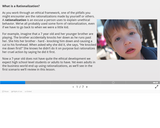
What is a Rationalization?
- Subject:
- Business and Communication
- Material Type:
- Interactive
- Provider:
- Michigan Virtual
- Date Added:
- 06/26/2019

What is a Rationalization?
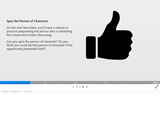
Spot the Person of Character

Becoming an Exemplar
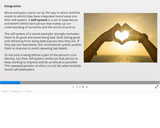
Integration
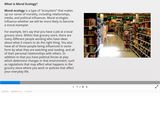
Moral Ecology
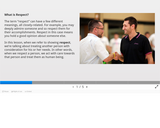
Respect
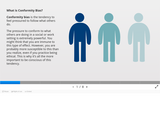
Conformity Bias

Free Riders and Outliers
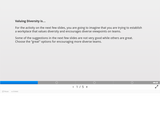
Activity: Valuing Diversity
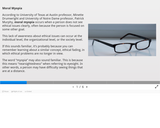
Moral Myopia

Tony Sarg was a puppeteer and marionette master who invented the first, larger than life, helium balloons for the annual Macy’s Thanksgiving Day Parade. The resource includes a lesson plan/book card, a design challenge, and copy of a design thinking journal that provide guidance on using the book to inspire students' curiosity for design thinking. Maker Challenges include: (1) Dash/Sphero: Develop a Macy’s Day Parade route using tape on the ground with a partner. Then, switch routes with another group and program the robot of your choice to navigate the parade route using code. (2) Ozobot: Develop a synchronized dance routine for both Ozobots for the stage of the Macy’s day parade using https://ozoblockly.com/editor (3) Create a moveable puppet that will be featured in the Macy’s Day Parade.
A document is included in the resources folder that lists the complete standards-alignment for this book activity.

The true, inspiring story of Beauty, the bald eagle, who was shot, rescued, and received a 3D-printed prosthetic beak. The resource includes a lesson plan/book card, a design challenge, and copy of a design thinking journal that provide guidance on using the book to inspire students' curiosity for design thinking. Maker Challenges: (1) Use paper and pencil to design a prosthetic body part for a human or animal. Then use tinkercad.com to create a prototype. Finally, use a 3D printer to print the prosthetic. (2) Have students research animals who use prosthetics. Then, improve the design in Tinkercad and 3D Print.
A document is included in the resources folder that lists the complete standards-alignment for this book activity.
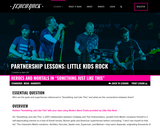
In this lesson, students use the lyrics to "Something Like This" as an opportunity to learn the stories of Achilles, Hercules, Wonder Woman and Superman. Students will explore similarities between these gods and superheroes, finally considering why mortals still need superhumans, thousands of years later.
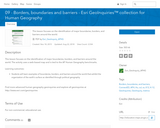
This lesson focuses on the identification of major boundaries, borders, and barriers around the world.

Using scrap metal and spare parts, William Kamkwamba created a windmill to harness the wind and bring electricity and running water to his Malawian village. The resource includes a lesson plan/book card, a design challenge, and copy of a design thinking journal that provide guidance on using the book to inspire students' curiosity for design thinking. Maker Challenge: Develop a way to harness the wind by designing with Strawbees.
A document is included in the resources folder that lists the complete standards-alignment for this book activity.

Ralph Baer’s family fled Nazi Germany for the US when he was a child. Using wartime technology, Baer thought outside the box and transformed the television into a vehicle for gaming. His invention was the birth of the first home console, the Odyssey, a precursor to the Atari gaming system. The resource includes a lesson plan/book card, a design challenge, and copy of a design thinking journal that provide guidance on using the book to inspire students' curiosity for design thinking. Maker Challenges: (1) Think outside the box. What’s something you use everyday, but not for its “intended” purpose? Examples: A broom to clean the snow off your car windshield, a trash bag as a sled. Now, think of a problem you might have at school, home, et al. Invent an item that would solve this problem. (2) Let’s think outside the box! Design the latest and greatest technology for kids to hit the market! Make it the *most* fun anyone has ever had. You may NOT use anything on the market - any technology currently on the market is off limits. Use your imagination, do not put limitations on it, and be as creative as you can. (3) Use household items to create a prototype of your new invention.
A document is included in the resources folder that lists the complete standards-alignment for this book activity.
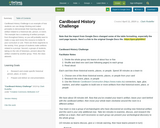
Cardboard History Challenge is an example of how students can use design thinking and maker principles to demonstrate their learning about an artifact related to a historical site, person, or event. The example has a scattering of artifact prompts from throughout history, so you will probably want to make a copy and revise this resource to better fit your curriculum or unit. There are three segments to the activity. First, groups of students make artifacts related to a prompt. Second, a groups of students, taking on the role of historians, present about the artifact created by another group. Third, the class debriefs.

A citizen is someone who is entitled to the legal rights granted by a state, and who is obligated to obey its laws and to fulfill certain duties. Living in the United States does not mean that someone is automatically a citizen. Permanent residents, people who have been lawfully admitted to the United States, are also granted certain legal rights and protections even if they are not citizens. For example, residents can live and work anywhere in the United States, attend public schools, join our armed forces and can also qualify for some Social Security benefits as well. Typically, people who are granted permanent resident status are immigrants who are related by birth or marriage to U.S. citizens or possess important job skills needed in the United States. Unlike citizens, permanent residents may not be able to hold public office or vote in elections. Why should someone consider becoming a citizen if they are not? Check out a list of all of the privileges of citizenship in the United States.

In a letter written to James Madison in 1797, Thomas Jefferson wrote, “The principle of the Constitution is that of a separation of legislative, Executive and Judiciary functions, except in cases specified. If this principle be not expressed in direct terms, it is clearly the spirit of the Constitution…” The separation of powers was one of the fundamental principles of the Constitution’s Framers. The Legislative Branch is sometimes referred as the “people’s branch” since the Founders believed and intended the legislative branch to closely reflect the will of the citizens.

Two blobs of clay go on an enjoyable adventure as they transform themselves into fun shapes and new things throughout their escapade. What will they be by the end of the book? The resource includes a lesson plan/book card, a design challenge, and copy of a design thinking journal that provide guidance on using the book to inspire students' curiosity for design thinking. Maker Challenge: Design a stop-motion video that morphs an item of your choice into another item. Before you begin, sketch out the process you’ll take to transform your item.
A document is included in the resources folder that lists the complete standards-alignment for this book activity.